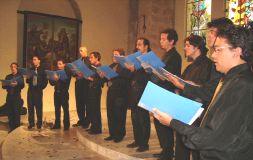13.7.4 Camerata Vocale Sine Nomine

Camerata Vocale Sine Nomine, a Cuban choral group, founded in 2003 in Havana by its then director, Enrique Filiú. This position was later taken over by Alexis Rodríguez Martínez, a graduate of the Instituto Superior de Arte (ISA) (1110 Calle 120 between 9th and 13th, Cubanacán, Playa, Havana). It is currently conducted by Leonor Suárez.
Vocale Sine Nomine’s debut took place during the II Esteban Salas International Early Music Festival on January 11, 2004. The group is made up of 12 men.
The Camerata Vocale Sine Nomine is a very unique vocal group, as it consists entirely of male members. They not only perform the bass and tenor registers, but also those currently associated with female voices. It is a male choir that uses the soprano, alto, tenor, and bass voices. Therefore, it is unique in its class within the field of contemporary choral music in Cuba.
The group recreates the period from the Middle Ages until well into the Baroque period, when women were prohibited from singing in public, so men had to interpret the timbres of female voices.
Its repertoire is extensive, bringing together pieces composed from the 15th century in Europe to the 19th century. It features works by Cuban composers Esteban Salas, Sindo Garay, and Miguel Matamoros, among others. Among the highlights are Perla Marina and Dulce Embeleso.
Three years after Vocale Sine Nomine was founded, they released their first album, a recording of works by Esteban Salas. For the performance of these pieces, they were accompanied by the early music ensemble Ars Longa, thus completing the necessary format. This album won the special award at the 2005 Cubadisco Festival.
This vocal group has performed in various concert halls in Cuba and has shared the stage with renowned Cuban choral groups such as Schola Cantorum Coralina, Ensemble Vocal Luna, the Havana Polyphonic Choir, and Vocal Leo.
In 2007, Vocale Sine Nomine performed in a recital in Ordizia as part of the Barroko Aire concert program, the second concert in the series. Among other works, they performed Officium Hebdomamadae Santae by Esteban Salas.
At the end of this same year, he premiered Psalm XXIII in the concert hall of the Basilica
Minor of the Convent of San Francisco de Asís (Offices between Amargura and Churruca, Old Havana, Havana). They also toured Spain and participated in the 39th Tolosa International Mass Choral Competition.
At the end of 2009, they gave a concert at the Church of San Francisco de Paula (Ave. Del Puerto and San Ignacio, Old Havana, Havana), where they presented their album titled Retrato a cappella, from the Cuban label EGREM, which won the Cubadisco Award for choral music.








